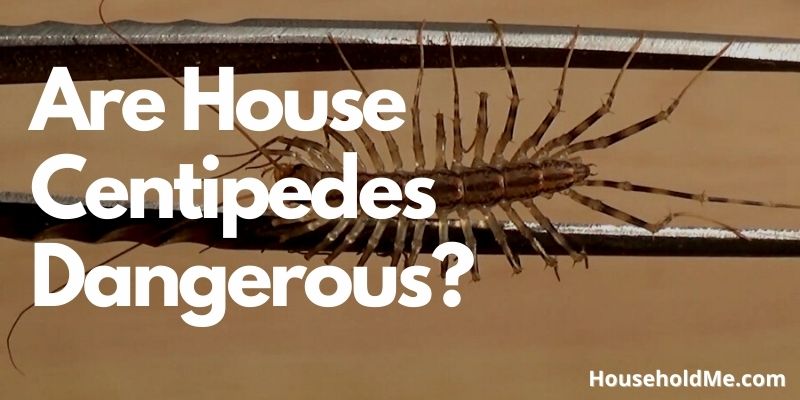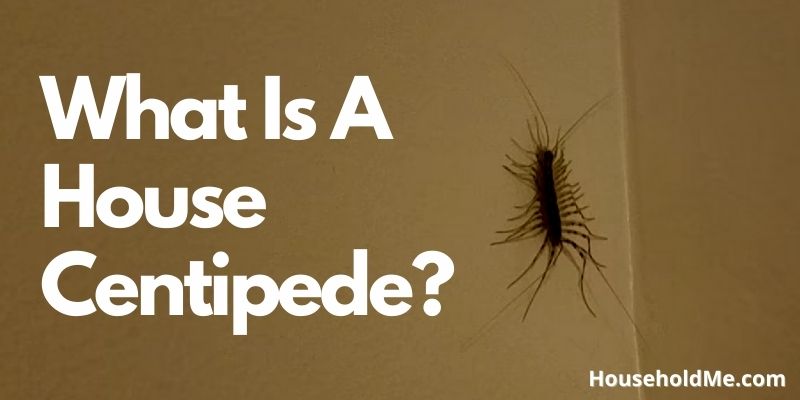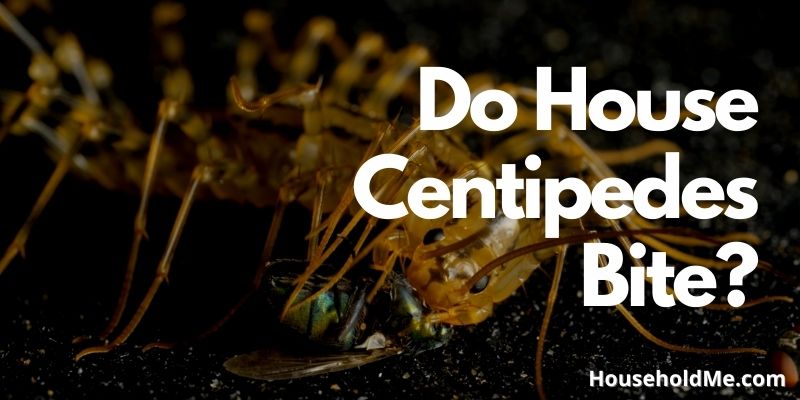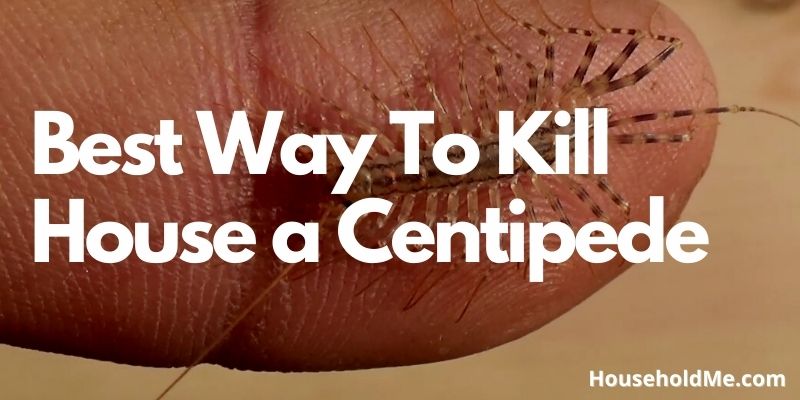The good news is that house centipedes, though alarming when they come running out from under the kitchen counter in super-speed mode, are not considered dangerous to humans. The article you are reading now will tell you more about the Scutigera coleoptrata, generally known as the house centipede. Learn all of their secrets!

Did you know: There are more than 2,000 species of centipede in existence. The number one fact you should know about them? They’re all carnivorous! Yes indeed – they feast on insects and other smaller creatures.
What Is A House Centipede?
House centipedes are small but very pesky creatures that often find their way into our homes.
The house centipede is known by its name, which means “one hundred legs.” However, they can have 15-177 total body segments depending on the exact species.

House centipedes are typically yellowish-brown or dark brown with darker markings on their bodies. They may not have any at all, though!
House centipedes are one of the most infamous species in our homes, preying on various insects with their poison claws.
What Does A Centipede Look Like
House centipedes have an elongated, worm-like body with many pairs of legs.
Depending on the species, the number of legs on a centipede can vary from 15 to 177.
Centipedes are exciting insects with an odd number of pairs of legs.
What Colors do House Centipedes Have
The coloration of centipedes can be any shade from yellowish to dark brown, with darker stripes or markings.
The heads of centipedes are covered with hairs that act as antennas. These animals are susceptible and can detect prey at great distances.
Their mouth is small, and they have large, claw-like structures with a gland full of venom.
Some centipedes have compound eyes with about 200 optical units, while others possess a cluster of simple ones on each side.
Are House Centipedes Dangerous To Humans?
House centipedes are not dangerous to humans, but they have venom that can cause pain and swelling.
House centipedes may not seem like a big deal, but they can annoy people and property. They are typically considered “nuisance pests,” which means their presence doesn’t cause any significant harm or risk to human health.
Centipedes are little creatures, but they’re not as dangerous and certainly don’t deserve to be scared away.
Are Centipedes Dangerous to Dogs?
Dogs are generally not affected by eating centipedes or receiving a bite from one.
Sometimes, the two animals will bay at each other in areas of thick clutter outdoors.
However, the number one threat to your dog’s health is still pests like ticks and fleas.
Are Centipedes Dangerous to Cats?
Cats are natural hunters, and when they see a centipede scurrying about the room, their prey will be right there for the taking.
Clashes can happen in kitchens, bathrooms, and basements.
The small house centipede is a generally harmless creature to cats, though they can still cause some discomfort.
Centipedes are not dangerous, but they can bite when threatened. However, it’s important to keep your cat away from larger centipedes, as they can bite and cause minor injury.
Do House Centipedes Bite?

As said, house centipedes are shy creatures that rarely bite humans. However, when they do, the wound can be pretty painful.
Thankfully, the venom of the centipede is not strong enough to cause any serious medical problems in humans.
Identifying a Centipede Bite
Centipedes have uniquely shaped legs used as claws and can penetrate their prey with their venom.
House centipede bites are painless, but can cause a red area with two puncture marks where they inject their venom into the skin.
Their bites usually appear like two punctures, similar in appearance to a spider bite.
The degree of pain you feel will depend on how much venom is injected into the bite. The smaller the centipede, like the house centipede, the less likely you will feel any pain.
Centipedes are not harmful to humans, but it’s always best to contact your doctor immediately after being bit so they can determine what treatment would be most suitable for the situation.
They can provide invaluable insight into how best to manage the situation and information about preventative measures that will avoid secondary infection.
Why do I Have a House Centipede Problem?

House centipedes are happy to live in damp, dark places during the day, like under mulch or stones. They’ll also hideout among leaf piles and vegetation that’s decayed enough for them!
The centipedes are intelligent creatures that can sense when their outdoor environment becomes too hot or dry. They then move indoors in search of a place with more humidity, but not as hot or cold!
House centipedes are often found in homes, ancient buildings, or foundation cracks. They can enter through gaps under doors and around utility entrances as well!
They can be found inside, on top or below ground level, but they don’t hesitate to go into dark places where there’s food abundance, such as cabinets filled with pots and closets containing winter clothes!
Best Way To Kill House a Centipede

House centipedes are one of the most common pests in homes, but they can be tricky to get rid of. Professional pest control experts know how best to deal with these pesky creatures.
However, we recommend to:
Never Kill a House Centipede
When you see a centipede in your home, the most likely response involves grabbing something like shoe crushing them immediately.
But like most other bugs, a centipede does have good intentions.
Here’s why you might want to keep them around.
What Do Centipedes Eat?
House centipedes are natural predators. They live in your house to kill the most unwanted pests – roaches, flies, silverfish, termites, and moths.
Centipedes use two legs around their head that carry venom, while the other legs attack the prey.
The centipede uses the lassoing technique to jump onto the victim and capture it with its many legs.
House centipedes are the ultimate experts at killing bugs you don’t want in your house. At the same time, they won’t make nests or webs, either!
They are always on the lookout for their next prey; hence they’re called active hunters.
Centipedes are not the enemy. They won’t hurt you or your home, and they don’t carry any diseases that you think might kill you.
House centipedes are just trying to catch bugs.
How Do I Prevent House Centipedes Entering my Home in the Future?
House centipedes are not known to be dangerous, but you must prevent them from coming into your home in the first place. Make sure all cracks and crevices have been sealed up tightly.
Make sure there are no gaps in your home’s foundation, exterior walls, and around utilities entering into the house.
When the heat is on, make sure to cover up any vents entering your home with mesh covers.
Fighting against humidity is a challenge. But you can reduce the amounts of water by running dehumidifiers in your basements and ensuring that crawl spaces are well-ventilated.
When bringing inside a potted plant, be sure to inspect it for centipedes before bringing it inside.
Make sure you clean up any clutter or excess debris in your house because it can accumulate unwanted moisture in walls.
House Centipede vs Silverfish: What’s The Difference
House centipedes are known for their dark bands along the length of each leg, while silverfish have legs that appear silvery or gray in coloration.
Centipedes have much longer legs than silverfish.
Silverfish have three legs that stick out from their abdomen, while centipedes do not.
